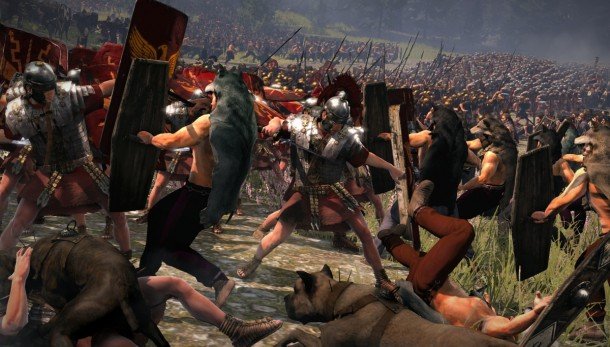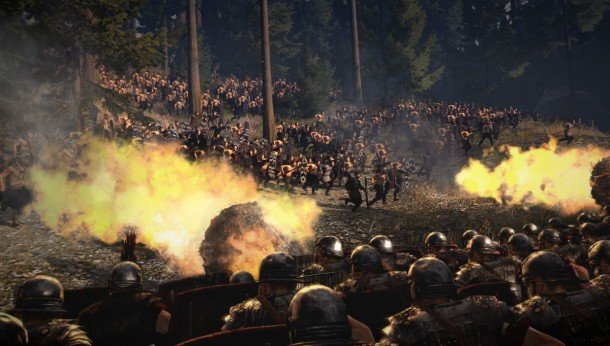Total War: Rome II preview - what's new in Creative Assembly's latest

The doors of Creative Assembly's Total War development fortress creaked open a little wider today with the release of a new trailer for Rome II's Battle of the Teutoburg Forest scenario . I saw this mission being played live a few months ago while visiting CA for the lead feature in PC Gamer issue 250 . It was the first time I'd seen the game being played properly rather than running as a pre-scripted demo (or while dressed up in black spandex and dancing around like a moron .)
There was a lot to take in, and you'll be able to read my full impressions in the preview feature which will be going up next week. Now that we're allowed to talk about it, however, I thought I'd rattle off a few of the key changes to the Total War formula that were shown off - or discussed - while I was there.
A simpler, stylised interface
Rome II's UI continues the trend of ornate, era-appropriate artwork that began in Shogun 2. Each faction has their own style - the Mediterranean factions, for example, are themed around Greco-Roman pottery. Unit cards are a little larger, by default, but can be minimised - and they'll shrink when your army grows, like the icons on an iOS dock. It didn't look like any elements had been removed - mousing over units still brings up a detailed status indication, for example - but there's been an evident effort to get you looking at the battle more and the interface less, which I like.
More varied individual soldiers
The version of the game I saw was reportedly pre-alpha, and I was told that there's still work to be done inserting greater variety into the game in terms of animation - there were a few awkwardly synchronised moments in the demo, as is Total War tradition. Nonetheless, the guys from CA spent a lot of time excitedly pointing out little details that add granularity and visual interest to Rome II's battles. There's now height variation between soldiers, with the Germanic forces notably taller than their Roman rivals. Men coming under fire from a unit of archers raise their shields dynamically as individuals. Slight differences in equipment establish the idea that these are individuals, not clones.
This extends to voice work, too: the orders you can hear being yelled if you zoom in close enough are situation-appropriate. A few I heard were definitely scripted for the Teutoburg Forest scenario - Roman leader Varus, for example, yelling for someone to go and find German 'ally' Arminius and his auxiliaries - but others weren't, and I was told that this is another way that CA are trying to communicate battle information in more interesting ways.
Keep up to date with the most important stories and the best deals, as picked by the PC Gamer team.

Tactical view
The new Total War's highest zoom setting pulls you right back out to a top-down view of the battlefield with units represented as translucent coloured rectangles. I was told that the art for this is currently a placeholder, and that CA are experimenting with a few different looks - including depicting troops as pieces of Roman-style coloured glass. The view was used sparingly during the demo, usually as a way to quickly confirm the position of multiple units before crashing back down to give orders at the unit level. I can see the two options working together well, due to a major change to Total War's battle mechanics:
Dynamic line-of-sight
In a first for the series, you are now only able to see what your men can see - no more abstraction of certain battlefield elements, no more always-visible generals represented by a star. This has the effect of making battles much more reactive - in the dense Teutoburg Forest, with its winding forest paths and multiple elevated ridge-lines, units could appear from the treeline or from around corners demanding an immediate tactical shift. According to the designers I spoke to, making this change has allowed them to fiddle with the pace and balance of battle in ways that will hopefully do away with some of the series' long-standing problems. Heavy cavalry units, for example, will now be limited by the fact that wearing a lot of armour means that they're not very maneuverable and they can't see very much. They'll need to be accompanied by light auxiliaries or scouts to be effective, and this in turn keeps lighter and faster units tactically relevant when a faction has the resources to afford more powerful troops. A modern analogy would be the relationship between a piece of heavy artillery and the advance spotters that mean it can actually hit something.
It also means that it's potentially possible for an army to disguise its numbers or composition right up until the point where it lands on top of an enemy. I'm really excited about the potential this has - as ancient history nerds will know, there are innumerable instances where misinformation and deception earned victories for smaller forces that seem impossible on paper.
Baggage trains!
Creative Assembly were still experimenting with the inclusion of optional objectives for regular battles when I spoke to them, but one example that was mentioned was the presence of an army's baggage train as a static encampment behind the lines of each engagement. Capturing or destroying supplies would be a way for a clever, maneuverable army to get the better of a larger one. Again - the way this works as a part of a regular campaign is still being worked on. But it's great that they're working to provide ways to win besides 'bringing more dudes.'

Persistent terrain and ambushes
Once a terrain map is generated for the campaign it'll be persistent for any subsequent battles that take place in the same area - in previous Total War games, a series of variously hilly, flat and coastal maps were rotated in and out for each new battle. What this means is that players will become familiar with the best places to attack, defend, and ambush enemy armies, turning the home-field advantage from a rule-based mechanic to a dynamic one based on your tactical understanding of your territory.
This works hand-in-hand with the ambush feature, which lets you put armies into hiding ready to jump out at anyone - enemy or ally - that you'd like them to force into battle. In ambush scenarios, the defending army won't get a chance to deploy: they'll be marching in a line when the battle starts and will have to move into defensive formation as soon as possible. The Battle of the Teutoburg Forest is a standalone mission, but hopefully situations like it will be repeatable in the main campaign.
Assuming direct control
Shogun 2: Fall of the Samurai allowed you to fire certain pieces of siege equipment - such as the gatling gun - directly, using a crosshair. This feature will return in Rome II for siege equipment. I haven't seen it in play yet, so that's about all I know - but expect to manually fire some trebuchets.

Dynasty warriors
We still haven't seen the new campaign map, but a few details crept out. When selecting a faction you'll also choose which political power you belong to - in the case of the Romans, these are the Junii, Julii and Cornelii. You are still playing as Rome, effectively, but the presence of other interest groups within your faction gives you something to consider at home as well as abroad. The designers I spoke to described this as a substantially expanded version of Shogun 2's loyalty mechanic.
Sudden but inevitable betrayal
Creative Assembly are experimenting with ways to keep the game interesting when your power as a faction has reached critical mass. The clean-up phase has always been a weakness of the series, the point in the game where you can't be stopped, and the road to victory looks a lot like clicking 'auto resolve' over and over again. Part of this will be an expanded reputation system where your deeds throughout the entire campaign are remembered: brutality towards one enemy will be factored in by the others you might face, meaning that you'll face increasingly violent opposition even from enemies who you otherwise outnumber, or alliances of necessity formed in the face of your rolling war machine. Likewise, internal politics can lead to your faction facing outright civil war when power vacuums form. It all sounds very appropriate to the period. The Romans had a bit of a problem with uppity generals crossing important rivers, don't you know.
Joining in 2011, Chris made his start with PC Gamer turning beautiful trees into magazines, first as a writer and later as deputy editor. Once PCG's reluctant MMO champion , his discovery of Dota 2 in 2012 led him to much darker, stranger places. In 2015, Chris became the editor of PC Gamer Pro, overseeing our online coverage of competitive gaming and esports. He left in 2017, and can be now found making games and recording the Crate & Crowbar podcast.


